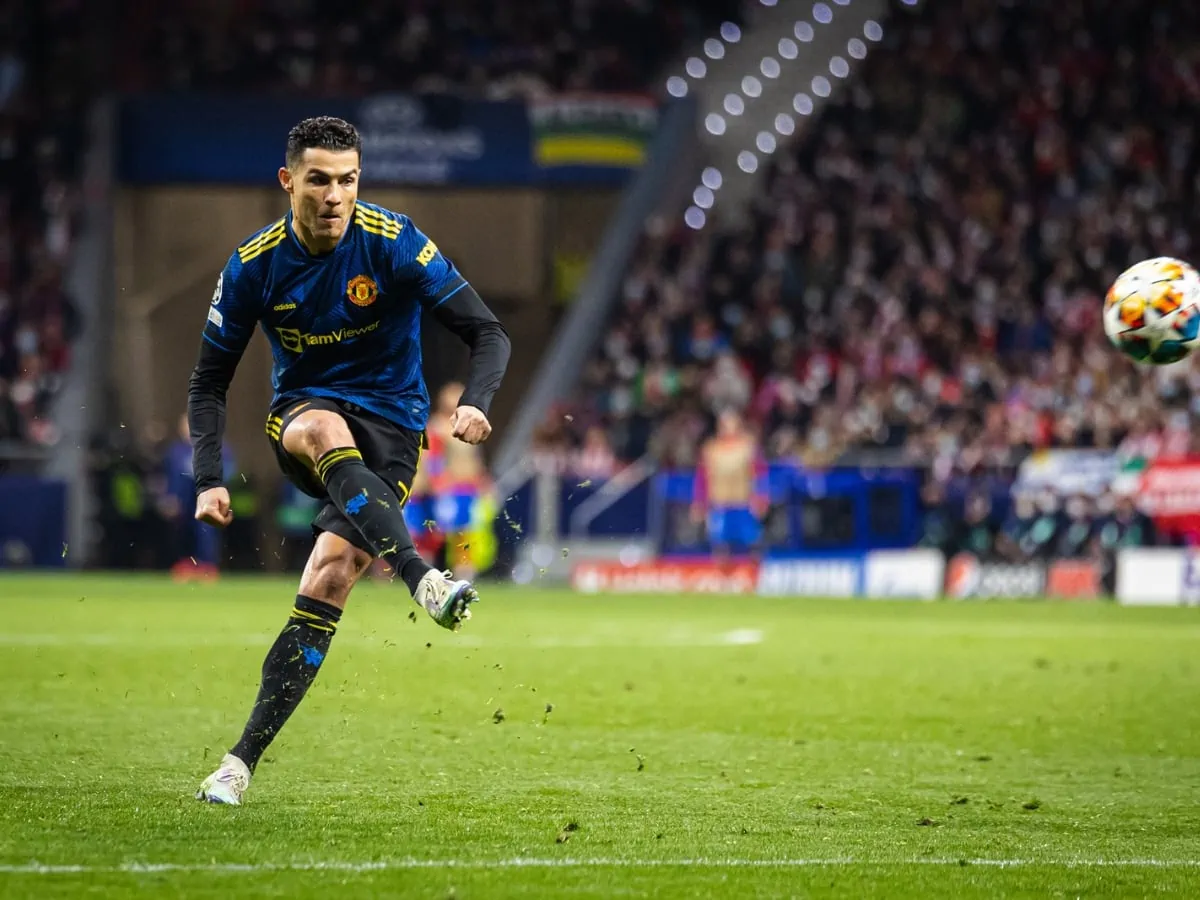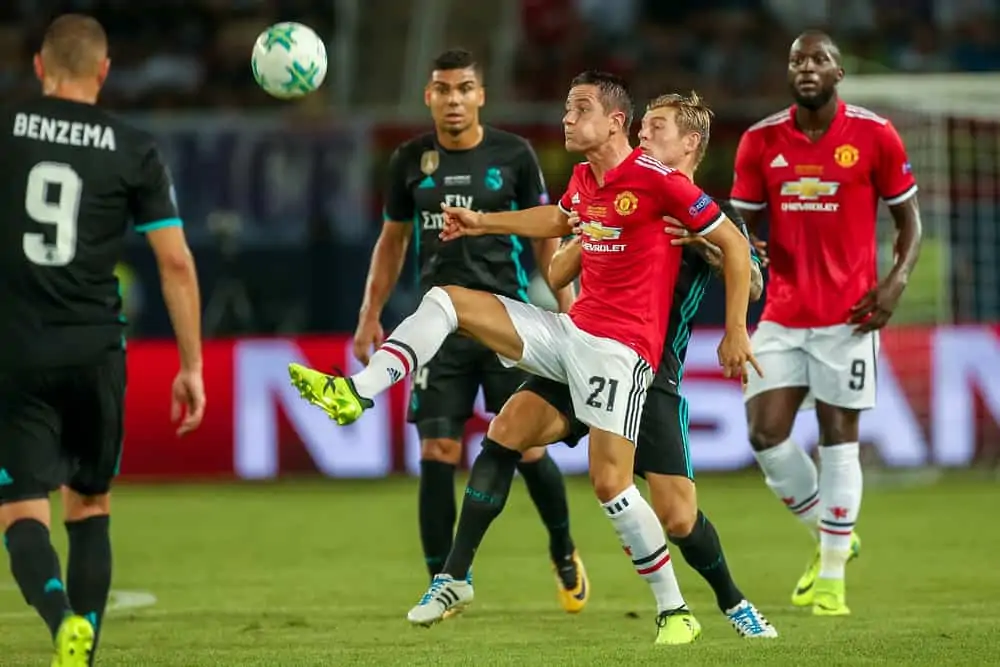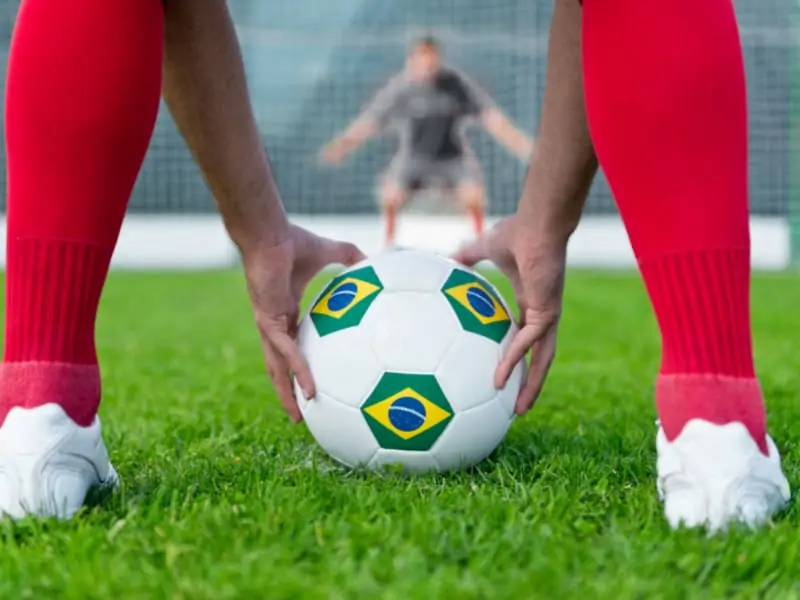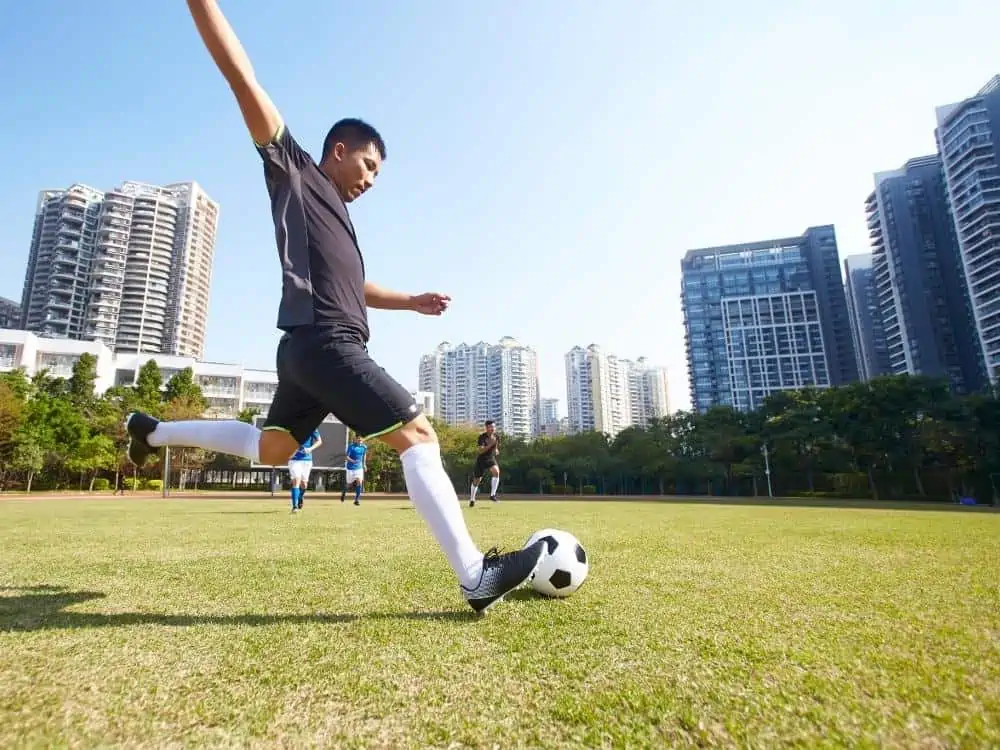Share the post "How to Kick a Knuckleball (Power Without Spin)"
In soccer, kicking the ball without spin is called a knuckleball. The ball won’t spin as it flies through the air.
This type of shot is powerful and can be unpredictable for the goalie.
Today, we’ll cover these keys points:
- Posture for a free-kick
- The sweet spot to strike the ball
- Kicking a knuckleball
A knuckleball aimed at the top corner will give the goalie little chance of stopping it.

How to kick a soccer ball without spin
To kick a soccer ball without spin, you’ll want to focus on these 4 areas:
- Set up
- Run up
- Ball striking
- Follow through
We’ll use a free-kick as an example scenario and cover these 4 in more detail. Then, you can start practicing the technique and perfecting your knuckleball.

1. Set up
Firstly, make sure your soccer ball is regulation size. That is a size 5 soccer ball. Also, you’ll want the ball to be well-inflated.
Soccer balls that are too soft get more spin.
We want to avoid spin with this technique, so get the ball pumped up.
When you’ve got this sorted, you’ll want to find a good place to practice. Shooting against a wall can be a good idea because the ball will return to you.
It means you can spend more time practicing and less time running after the ball. For set-up distance, it’s best to be outside the 18-yard box. So, start about 20-25 yards away from your target. That should be a good distance.
If you’re uncomfortable with kicking that distance, it’s fine to take the ball closer.
Once you’ve selected your distance, find the valve of the soccer ball. This is the part you pump air through to inflate it. Place the ball so that the valve is facing you and position it so that the valve is in the center.
This will help you to strike the ball in the right spot.
Now, before you kick the ball let’s cover the run-up.

2. Run-up
For the run-up, you can use your normal one if you already take a lot of free-kicks. But if you don’t take free kicks or haven’t practiced them, we’ve got you covered.
Stand at the ball and take 4 steps backward. Don’t take little steps but the biggest steps you can comfortably take.
Just don’t overstretch.
When you’re 4 steps back, take 2 side steps to your left if you’re right-footed – 2 steps to the right if you’re left-footed. This will create a slight angle for your approach, which is best for kicking a knuckleball.
Before you run up, stand tall with your chest up and shoulders back.
Imagine you’re going to fight with the ball and are making yourself look bigger.
Check out this video of Ronaldo’s famous free-kick against Portsmouth in the English Premier League to get an idea.
Notice how he stands before taking the kick. He almost looks like a gunslinger in an old western movie.
Copy this posture because you want your body to be quite upright when you’re striking the ball.
When you’re running up to strike the ball, keep the weight on the balls of your feet. This will give you good momentum for a powerful strike.
You’ll want to plant your supporting foot level with the ball, and about 6 inches to the side, when you’re about to strike the ball.
So, if you’re right-footed, you’ll plant your left foot level with the ball and 6 inches to the left side. If you’re left-footed, you’ll plant your right foot level with the ball and 6 inches to the right side.

3. Ball striking
Striking the ball in the right spot is essential so you don’t get any spin. Remember we positioned the valve in the center of the ball? You’ll want to strike the ball about 2 inches below the valve.
This will give your shot the best height without giving any spin.
If you strike the ball exactly in the center, you won’t get any height on your shot. And striking it too far below the center will give you too much height and some backspin.
Now that we know where to strike the ball, let’s look at the best way to strike it.
You’ll want to use your laces for a powerful shot without any spin.
Avoid kicking with the inside or the outside of your foot. And don’t use the toe of your foot.
For the knuckleball, you should strike with the sweet spot of your cleats. The sweet spot is around the area of the bottom 3 holes for your laces.
If you’re right-footed, the sweet spot is the bottom 3 holes and slightly to the left. It’s the bottom 3 holes and slightly to the right if you’re left-footed.
Striking with the sweet spot of your foot about 2 inches below the valve is the best for creating no spin.
Watch this short video to get a better idea:
Remember to hold your posture when you’re striking the ball. You don’t want to be too stooped over.
Stay tall without leaning back.
4. Follow through
Once you strike the ball, your follow-through is important.
You don’t want to take a full follow-through. But you don’t want to stop immediately upon impact, either.
To start, you can mark a line ahead of the ball with tape. Make it about 2 feet in front. You’ll want to think about keeping your follow-through inside this line.
Now, your momentum might take your further forward and over the line. That’s fine. We just want you to think about keeping the follow-through short.
If you try to keep the follow-through within the line, you won’t do a full follow-through.
And we want to avoid a full follow-through.
Having a line there is a good reminder. It’ll make sure you concentrate on keeping the follow-through short and sharp.
When practicing the knuckleball, don’t worry about hitting the target to start with. Just focus on the 4 areas of the technique.
Get the ball flying without any spin. Then, you can start aiming for specific targets.
The knuckleball is probably the hardest shooting technique in soccer. It takes plenty of practice to master. So, don’t worry if you can’t do it for a while.
Keep practicing and have fun perfecting your technique. You’ll get there!
Share the post "How to Kick a Knuckleball (Power Without Spin)"
Joel is a seasoned soccer journalist and analyst with many years of experience in the field. Joel specializes in game analysis, player profiles, transfer news, and has a keen eye for the tactical nuances of the game. He played at various levels in the game and coached teams - he is happy to share his insight with you.



